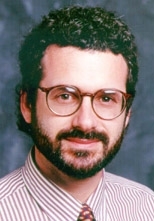Two MIT faculty members--Neil Gershenfeld and Ted Selker--have been named to the "Scientific American 50," the magazine's annual list of leaders in science and technology that will appear in its December issue on newsstands Nov. 23. The magazine also named Gershenfeld the Communications Research Leader of the Year.
Gershenfeld, director of MIT's Center for Bits and Atoms (CBA), was selected as the Communications Research Leader of the Year for "designing a communications protocol for connecting the hardware in a 'smart' household." The award was for an unexpected spinoff from CBA research that resulted in the development of an Internet architecture for things, called "Internet 0." Internet 0 extends the original "internetworking" ideas behind the Internet down to individual devices.
"Internet 0 enables interdevice internetworking and end-to-end modulation," said Gershenfeld. "It is emerging as an alternative to the myriad ways people are currently connecting things to computers--like RFID tags, Bluetooth peripherals, X10 appliances, bar codes, etc.--making them all part of the Internet. It natively uses the Internet protocols, the signals are the same for all devices (a bit like Morse Code), it operates without relying on central servers, and the hardware can cost less than a dollar."
At a recent meeting at MIT, many of the original Internet architects and their current counterparts discussed the close parallel between the way the Internet originally connected heterogeneous networks and the way Internet 0 now is connecting heterogeneous devices. Internet 0 grew out of earlier testbed installations Gershenfeld did at the Museum of Modern Art in New York City, the White House/Smithsonian Millennium events in Washington, D.C., and the "Media House" in Barcelona. Internet 0 was developed by Gershenfeld, his graduate student Raffi Krikorian and Danny Cohen, now at Sun Microsystems, who helped create the Internet's IP protocol.
Selker honored for Voting Technology Project
Selker, a professor in the Media Lab and the MIT director of the Caltech/MIT Voting Technology Project, was honored jointly with his counterpart at Caltech, Professor Michael Alvarez, for "recommending sweeping changes to overhaul U.S. voting systems." Selker and Alvarez were selected as Policy Leaders in the computing category of the Scientific American 50.
The Caltech/MIT Voting Technology Project was established in late 2000 in the aftermath of the U.S. Presidential election with the goal of preventing the recurrence of the problems with that election. President David Baltimore of Caltech and MIT President Charles M. Vest initiated the project as a cross-disiplinary effort funded by the Carnegie Foundation and the Knight Foundation.
"The project achieved much more than anyone could hope for," said Selker, an associate professor who leads the Context-Aware Computing Group at the Media Lab. "We were listened to by legislators, election officials, lobbyists, voters and election machine manufacturers. We have had tremendous successes at bringing new data and analysis to the field, inventing better security approaches, ballot designs and processes. Our work helped motivate the Help America Vote Act and is finding its way into new voting equipment and statements made by the Election Assistance Commission and election officials. With funding and effort, the American voting systems can become exemplary machinery to run democracies."
An MIT team began reviewing equipment, election data and people's performances with scientists from Caltech early in 2001. By July of that year the team, which included Selker, professors Stephen Ansolabehere and Charles Stewart of political science, Stephen Graves of management, and Alex Slocum of mechanical engineering, had created a groundbreaking report and the beginnings of prototypes.
"We brought in students who found themselves learning and working in a nascent field that crosses many boundaries," said Selker. "The project has given me a fantastic opportunity to learn with and from broadly different world-class scientists."
Others involved in the work include graduate students Ben Adida, Sharon Cohen, Matthew Hockenberry, Soyini Liburd, Sarah Sled and Shawn Sullivan, and alumnus Jonathan Goler (S.B., M.Eng. 2004).
The Scientific American 50 was selected by the magazine's board of editors and a group of outside advisors. The list recognizes research, business and policy leaders in several technological categories. The winners will be honored Nov. 16 at a celebration at the New York Academy of Sciences.
"Scientific American believes strongly that the best hope for a safer, healthier, more prosperous world rests in the enlightened use of technology," said John Rennie, editor-in-chief. The magazine was founded in 1845; this is the third year it has published the list. Past winners included Gro Harlem Brundtland, former World Health Organization Secretary General, and Steven Jobs, CEO of Apple.
A version of this article appeared in MIT Tech Talk on November 10, 2004 (download PDF).







